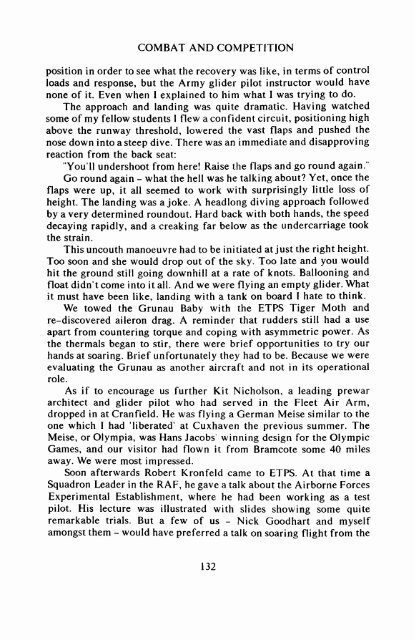COMBAT AND COMPETITION.pdf - Lakes Gliding Club
COMBAT AND COMPETITION.pdf - Lakes Gliding Club
COMBAT AND COMPETITION.pdf - Lakes Gliding Club
Create successful ePaper yourself
Turn your PDF publications into a flip-book with our unique Google optimized e-Paper software.
<strong>COMBAT</strong> <strong>AND</strong> <strong>COMPETITION</strong><br />
position in order to see what the recovery was like, in terms of control<br />
loads and response, but the Army glider pilot instructor would have<br />
none of it. Even when I explained to him what I was trying to do.<br />
The approach and landing was quite dramatic. Having watched<br />
some of my fellow students I flew a confident circuit, positioning high<br />
above the runway threshold, lowered the vast flaps and pushed the<br />
nose down into a steep dive. There was an immediate and disapproving<br />
reaction from the back seat:<br />
"You'll undershoot from here! Raise the flaps and go round again."<br />
Go round again - what the hell was he talking about? Yet, once the<br />
flaps were up, it all seemed to work with surprisingly little loss of<br />
height. The landing was a joke. A headlong diving approach followed<br />
by a very determined roundout. Hard back with both hands, the speed<br />
decaying rapidly, and a creaking far below as the undercarriage took<br />
the strain.<br />
This uncouth manoeuvre had to be initiated at just the right height.<br />
Too soon and she would drop out of the sky. Too late and you would<br />
hit the ground still going downhill at a rate of knots. Ballooning and<br />
float didn't come into it all. And we were flying an empty glider. What<br />
it must have been like, landing with a tank on board I hate to think.<br />
We towed the Grunau Baby with the ETPS Tiger Moth and<br />
re-discovered aileron drag. A reminder that rudders still had a use<br />
apart from countering torque and coping with asymmetric power. As<br />
the thermals began to stir, there were brief opportunities to try our<br />
hands at soaring. Brief unfortunately they had to be. Because we were<br />
evaluating the Grunau as another aircraft and not in its operational<br />
role.<br />
As if to encourage us further Kit Nicholson, a leading prewar<br />
architect and glider pilot who had served in the Fleet Air Arm,<br />
dropped in at Cranfield. He was flying a German Meise similar to the<br />
one which I had 'liberated' at Cuxhaven the previous summer. The<br />
Meise, or Olympia, was Hans Jacobs winning design for the Olympic<br />
Games, and our visitor had flown it from Bramcote some 40 miles<br />
away. We were most impressed.<br />
Soon afterwards Robert Kronfeld came to ETPS. At that time a<br />
Squadron Leader in the RAF, he gave a talk about the Airborne Forces<br />
Experimental Establishment, where he had been working as a test<br />
pilot. His lecture was illustrated with slides showing some quite<br />
remarkable trials. But a few of us - Nick Goodhart and myself<br />
amongst them - would have preferred a talk on soaring flight from the<br />
132

















